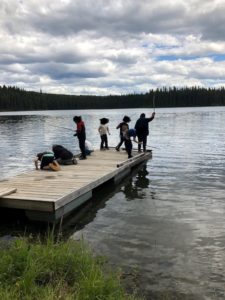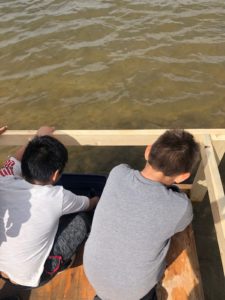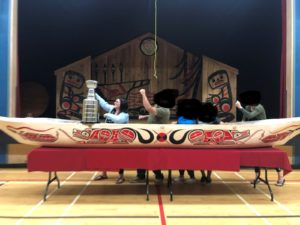
I attended the BC Professional Development Day with Mariah Bouchard and Allison Cuthbertson on Friday October 23, 2020. It was such an amazing experience to co-collaborate and co-learn with my fellow classmates. These workshops were incredibly motivating and inspiring. The three of us attended three workshops via Zoom and here these are my takeaways from today’s Professional Development Day. The names of the workshops we attended were:
1) Sharing Early Years Wisdom as a Community of Practice
2) Place in Your Face: Place Based Learning in the Fraser Canyon
3) Learning on the Land/Water: Territory, Culture, Community and K-12 Curriculum.
Workshop #1 – Sharing Early Years Wisdom as a Community of Practice
The first workshop was about a group of early childhood educators, community partners, and primary teachers from SD #8 that were curious about the transition and school readiness for children coming from daycare and moving into kindergarten. For example, how do children coming from daycare transition to kindergarten in the easiest way possible? These early childhood educators and primary teachers started off small, beginning with a conversation on how they were going to support families and children with their gradual entry and transition to kindergarten. Their priority with transitioning kindergarteners was making sure all children and families had a great understanding of school readiness. They used a community practice style/format where they gathered the necessary information, knowledge, experience, and practices from experts all around Canada specializing in early primary years. Further, they invited different districts, community partners, and early childhood instructors to come together to share experiences, practices,expertise, guidelines, and protocols on the topic of school readiness in early years. They addressed the importance of soft starts in primary and early childhood years. Their school readiness program had very useful tools, focusing on self regulation and co regulation-focused attention. It is called SEY2K.
“Children acquire the ability to self regulate by first being regulated. Co – Regulation is a process that must begin with you…so find what makes you calm and makes you happy.” Stewart Shanker 2012.
The workshop has reinforced for me a concept that is not always easy to address and/or tackle: change. Change is always possible, and it always comes from a place of curiosity, innovation, and growth. The presenters imparted to me that if you want to see change, you have to be that change; you need to model that change. By being at the center of that change, things will happen. How is made possible is starting with a conversation to share knowledge, worries, and concerns. Change can be scary, and therefore openly sharing worries and concerns is a necessary exercise. Kindergarten is a place for play and inquiry-based learning. An important aspect of transitioning to kindergarten is becoming more familiar with what kindergarten is. They developed kindergarten booklets explaining what kindergarten is, stories about kindergarten, and tools/tips parents can use to ease the transition. The booklets also contained information on the ways educators can and will support parents and their children in this process. What came evidently clear is that it takes a village or community to raise a child. Going to kindergarten is a big transition for many children – it takes the involvement and participation from many partners, the community, the school, our families, and our teachers.
Since the implementation of SEY2K, other school districts have adopted the program. The program creates a safe space for children and their families, allowing them a positive experience in their early years by making the flow from one program to another much easier. This approach allows for experiential, project based, play based, and hands-on learning to occur. This program models authentic teaching and, most importantly, provides the tools and confidence for our children to flourish in their early years of their educational journey. It was nice to hear that this program is always evolving, making little tweaks and changes as it is being implemented. The developers have a “the sky’s the limit” philosophy which shows their innovation!
Their motto: “If you are curious about your children’s learning and success, start small, start with a conversation, and start collaborating because wonders will happen”
Workshop #2 – Place in Your Face: Place Based Learning in the Fraser Canyon
Place In Your Face was a great workshop. I absolutely loved it, primarily because it touched on holistic education and its alignment to place and land based education. This workshop focused on how educators can use placed based teaching in their own teaching practice. I loved the medicine wheel check-in that the presenters used at the beginning of the workshop. The presenters asked us how we were feeling today using a 1-5 scale on the 4 quadrants of the medicine wheel: emotionally, spiritually, mentally, and physically. This check-in was so effective in making us aware of how we were feeling. For me personally, attending this workshop was very powerful because the presenters asked the participants to think of their own place they feel would be an ideal location to teach land and place based learning. A group of educators took 35 students and a resident elder to a field trip in the Fraser Canyon. Due to limited funding for this field trip, the educators and the students had to come together and approach the community partners for support. What I enjoyed the most about this workshop was the presenters’ ways of relating “our place” and “ourselves” to a location where we felt it would be a good place to practice place and land based education. The place I thought was an amazing spot for place and land based education was called Camp Ispah on the outskirts of Prince George. When I was as an educational assistant at Nusdeh Yoh for three years, I was so fortunate to be placed with Marianne, my classroom teacher who loved and advocated for land and place based learning. Every year, she took her class on a 3-day field trip to Camp Ispah (once in the summer and once in the winter). These camp trips were absolutely eye opening and amazing. Marianne planned these trips for her students twice a year and in order for us to go, we would apply for grants within the district, community school fundraisers, and bottle drives. She involved her students in the entire planning process. Camp Ispah was an incredible experience because Marianne would bring a resident elder, community support worker, people that worked in the ab ed department, and land based teachers with us on our field trip. The students learned about the history of trapping, hunting, fishing, and survival tips in the wilderness. The importance of storytelling was huge in Camp Ispah – every night we would all gather around the campfire and the resident elder would tell us a story about their history; some involved animals, some involved community. It was so entertaining and informative. I am so thankful for the many experiences, relationships, and knowledge I have gained from being a part of the Camp Ispah field trips. There is nothing more fascinating than seeing all of your students feel a part of something bigger than they are – connecting with their peoples, their land, and their place.
The picture below is one of my students and I at Camp Ispah in the winter – this was a 3-day field trip in the wilderness after a resident elder taught us how to ice fish

Camp Ispah (summer field trip). Every student had to find a stick and attach a piece of fishing line on the end of it and then go dig for a worm for bait. And yes, we did get minos!!

Workshop # 3: Learning on the Land/Water: Territory, Culture, Community and K-12 Curriculum
The third workshop I attended was about integrating land and water in one’s teaching practice and teaching philosophy. The importance of emerging Indigneous knowledge and perspectives into one’s teaching practice and philosophy can’t be over emphasized. This workshop was about a program called the Stewards program, located on BC’s central coast. This program was designed to promote land and place based learning, ensuring educators keep this concept and teaching approach at the forefront of their practice. Many of the educators from the Stewards program were noticing that they were ‘getting stuck’ in their traditional ways of teaching, without incorporating land and place based teaching. They decided it was time for a change, ensuring students were getting outside, connecting themselves with their land, places and peoples. These educators wanted to take a different approach to differentiated instruction and move the learning beyond the confines of a classroom. This program is very successful today and continues to be evolving in British Columbia. In many ways, this program is modelling the way for a lot more districts in our province. The program promotes inquiry based and hands-on learning. Students begin feeling a part of something because this program was implemented and designed to align with these students’ interests, cultures, and knowledge. The program also helps students find themselves and be a part of something bigger than they are. As I was participating in this workshop, it made me realize how much respect I have for these educators. I am a strong believer that educators must do everything possible to meet their students where they are at; and in order for the academics to happen, knowing your students and knowing their needs is a critical step. It makes me happy that Prince George SD #57 is modelling the way in connecting to land and water teaching. In Prince George, DP Todd Secondary school started the HAWK program. HAWK stands for History And Wilderness Knowledge. Local Prince George teachers Dave Leitch and Reid Roberts (@ReidRoberts13)started this program and it is so successful. These two local teachers designed this program for the students who did not fit into the mainstream educational system. This program is designed to ‘catch’ students who are slipping through the cracks in grade 10, being proactive before it is too late for graduation. This program has seen graduation rates increase, primarily because students are learning in a different way – something they are interested in. A novel concept indeed!!
I wanted to share a few pictures that show land and place based learning at Nusdeh Yoh:
Nusdeh Yoh students learned how to shoot a bow at its target, learning from a resident elder on how to properly hold the bow and the history of the Dakelh peoples and the bow

In Vanderhoof releasing sturgeons into the river – what a day of learning!!!!!!

Bigger Than They Are…
I was one of the head coaches of the Nusdeh Yoh Hockey Team – we won the cup for all the elementary schools that participated in the hockey tournament. We took home the cup and gold. I believed in my students, I put in the effort to help them succeed, I taught them how to skate and play hockey. I never gave up on my students and, most importantly, I gave my students a place outside of the classroom where they felt a part of something bigger than they are!!


A local handmade artist, Clayton Gauthier, crafted this canoe at Nusdeh Yoh. Each student had the opportunity to put ‘their little touch to it’, – our biggest confirmation that it takes a community or a village to raise a child.
